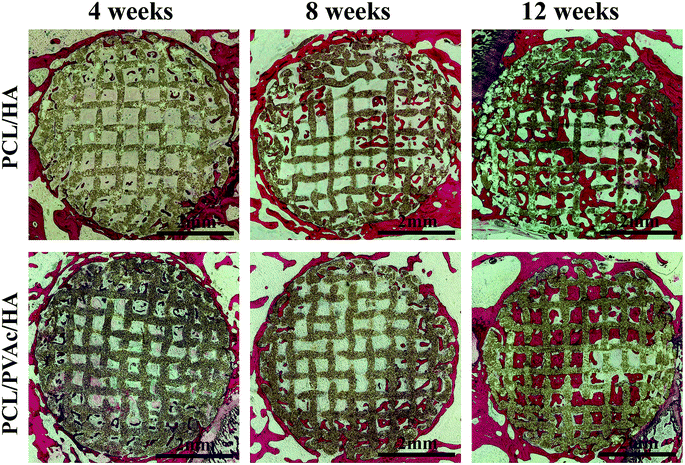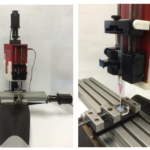

3D printing in medicine and in structures like scaffolding has become almost commonplace today, but scientists continue to refine the processes to help patients with a variety of conditions, many of which are life threatening. A team from the Research Center for Nano-Biomaterials at Sichuan University has recently decided to explore an important and relevant topic in ‘Modification of 3D printed PCL scaffolds by PVAc and HA to enhance cytocompatibility and osteogenesis.’
Four groups of scaffolds were 3D printed in the study, in the following materials:
- PCL
- PCL/PVAc
- PCL/HA
- PCL/PVAc/HA
The team studied their morphologies, mechanical properties, and biological characteristics, with two new types of bone formation patterns discovered during the study—one formed on the grid matrix and another as new bone remolded into circles after previously being formed in the middle of the structure.
In the introduction to their study, the researchers discuss the potential 3D printing offers for material scientists and orthopedic surgeons, as scaffolds can be made layer by layer in accordance with available and personalized CT data exhibiting bone defects.
“With the help of 3D printing technology, clinicians can fabricate scaffolds of different size, specific shape and porosity,” state the researchers.
PCL has been approved by the FDA and offers a suitable material for 3D printing scaffolds due to high crystallinity and a low melting point. The research team points out that it also offers ‘superior workability and machinability’ when printing at normal temperatures. The materials are already in use for a wide range of medical needs, including cranial repairs, screws to fix bone fractures, systems with sustained-release mechanisms, and already for use as a 3D printing matrix for hydroxyapatite scaffolds. PCL is also a bioabsorbable material that is deemed exceptionally safe.
With all the good of course, comes some ‘bad,’ and the team of scientists discusses the shortcomings they uncovered with PCL and hydroxyapatite (HA):
“On one hand, PCL is a hydrophobic material with no propensity for cell attachment. On the other hand, the degradation rate of PCL is very slow. A polymeric shell naturally forms on the stent of scaffolds during the printing process. Thus, it is difficult to expose the embedded HA particles of PCL matrix, which affects the bone-bonding function of HA material.”
The team goes on to point out the need for the following features in scaffolds:

- Controlled biodegradability
- Appropriate mechanical strength
- Interconnected pore structure
- Porosity for cell in-growth
3D printing is considered suitable for all these requirements because it allows for fabrication of the interconnected pores for bone regeneration.
The four scaffold groups were 3D printed on the 3D Bioprinter V2.0 (manufactured by Hangzhou Regenovo Biotechnology Co., Ltd, China), all on the same settings:
“0.34 mm diameter nozzle, a filament gap of 0.5 mm, a layer thickness of 0.1 mm, and a lay-down pattern of 0°/90°. The size of a filament gap was set as 0.5 mm in agreement with previous studies.14 Disc scaffolds of 14(D) × 1.5(H) mm were fabricated for in vitro cell culture. Column scaffolds of 5(D) × 6(H) mm were fabricated for in vivo studies. Rectangular scaffolds of 10(L) × 10(W) × 10(H) mm were fabricated for mechanical tests and other characterization analyses.”
The results showed that all scaffolds had similar porosity in the range of 74.1 percent to 76.1 percent, but there were differences in mechanical properties:
“The PCL scaffold held the highest compressive strength of 11.9 MPa (p < 0.05), while the PCL/HA scaffold had the highest modulus of 125.4 MPa (p < 0.05). The PCL/PVAc scaffold showed the lowest values of both the compressive strength (3.9 MPa) and modulus (26.6 MPa). The values of mechanical properties of PCL/PVAc/HA tri-component scaffold (6.3 MPa and 55.5 MPa) were higher than those of PCL/PVAc but lower than those of PCL and PCL/HA with no statistical difference observed among them.”
Overall, the scaffolds were successful, although the PCL/PVAc/HA scaffold showed more favorable characteristics during in vitro cell culture experiment and in vivo bone formation.
“The new 3D printed scaffold presents a promising prospect for future biomedical applications,” concluded the researchers.
Find out more about this study here. And if you are interested in finding out more about 3D printed scaffoldings, follow some of our other stories on topics like thermoresponsive nanohybrid scaffolds, lattices made in 3D printed rectangle form, and even neural scaffolds.
What do you think of this news? Let us know your thoughts! Join the discussion of this and other 3D printing topics at 3DPrintBoard.com.
[Source / Images: ‘Modification of 3D printed PCL scaffolds by PVAc and HA to enhance cytocompatibility and osteogenesis’]
If you're looking for affordable 3D visualization services in the USA, our platform provides an ideal solution for all your architectural and real estate needs. Through our service, you can access high-quality 3D renderings at competitive prices without compromising on quality. Whether you need interior visualizations, exterior renderings, or architectural animations, our team ensures that you get professional results that fit within your budget. With our support, you can make your projects visually stunning while saving on costs, all with a quick and straightforward process.
Through our site, you can easily order affordable 3D visualizations for your projects, whether for a residential property, commercial development, or architectural design. We understand the importance of staying within budget, and that's why we offer tailored solutions to ensure you get the best value for your investment. Our experts work efficiently to provide you with realistic, photorealistic 3D images that will elevate your presentations and attract clients, making your property stand out in the market.






